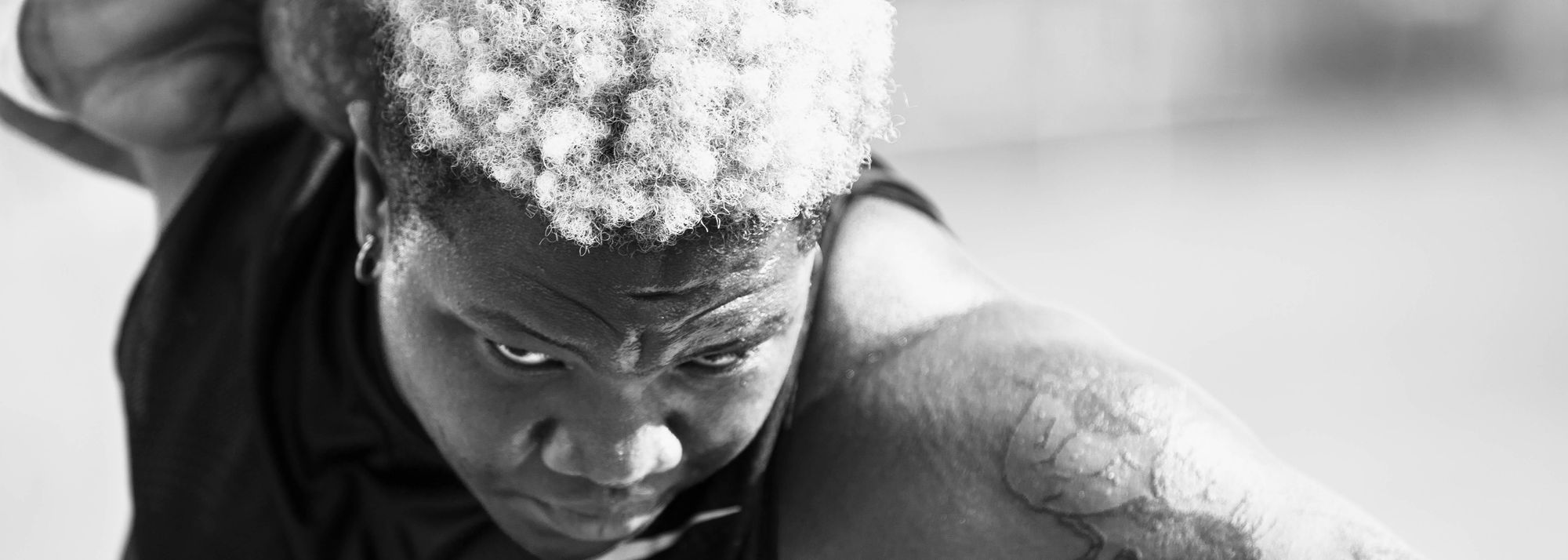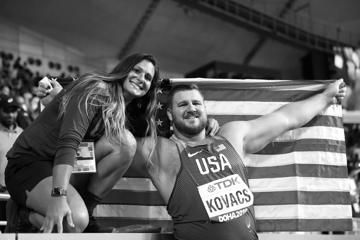Raven Saunders trains in Ostrava 2018 (© Dan Vernon)
The first person I texted was my therapist.
I already had my plan. I knew what I would do. I knew where I would do it.
For a few days, I’d drive along the same stretch of highway to the campus at the University of Mississippi and notice the huge drop-off to one side. Maybe this would be the day I’d go over the edge.
It was January 2018, my senior year at Ole Miss, and I remember waking up that day with a whole series of things to do. My mind was racing a thousand miles per minute but it was also in fog. I was unable to pinpoint one thing to do.
When I reached the campus, I didn’t stop as I had planned. I kept driving, and in those minutes I had flashbacks to so many things. I became aware that I felt really off, my mind in a daze.
Something told me to text my old therapist.
I hadn’t talked to her in about a year but she was the only one I felt comfortable enough to speak to in that moment. I started texting this super-long message about how I was done with everything. I can’t remember the specifics, but I alluded to the fact that I didn’t know if I’d be here tomorrow.
She told me to hold on, that everything is going to be alright – to sit tight while she got me help. She contacted the athletic director at Ole Miss, who called me into his office. He asked me how I was and I didn’t hide the truth. Later that day he helped me get checked into a mental health facility in the area.
That’s when I began to get better.
Looking back, I had depressive symptoms for many years. It’s only when I started therapy that I got to understand them, but the signs were there as far back as high school. They got worse when I went to college and I eventually listened to a friend’s advice to talk to someone.
I did that through the resources available at Ole Miss, but it took a long time before I truly started to use therapy for what it was for: venting and opening up about my personal life. When I did that, I was able to understand things better and it became a really nice way for me to get things out.
But by my senior year, I wasn’t going as much and in January of that year I had my first anxiety attack. The following day was when I considered taking my own life.
But after I got checked into the mental health facility, I started to turn a corner. My Mom flew in, staying at a hotel nearby, and I was able to see a doctor to address what was going on. I was 21 at the time and one of the youngest there, but being around people who were older and talking to them about their issues helped me feel a lot better. I wasn’t alone.
I learned techniques to control depression. For me it became about being more open and honest to the people nearby when I am going through things. I had to become very self-aware of triggers that would take me back to certain places.
Finding the right medication took a while and I learned ways to bring myself out of the darkest periods, ways to cope when it was at its worst, such as meditating.
If I’m in a weird space, sometimes it’s about trying to put myself around other training partners, to get out of the house and be productive.
To this day, it’s a daily battle. I can feel when my depression is trying to get at me but it’s about being fully aware of it and being able to acknowledge it, to address it and not let it fully consume me.
I practice positive affirmations, re-affirming all the good things to myself when depression wants to kick in and negative thoughts emerge. It’s a struggle, but once you get the right tools it’s a lot easier.
That, above all, is my message to others.
A few months ago, I told some of my story on social media and a lot of people reached out. There were a few college athletes, not just in track and field, who asked about my personal experience.
I know how big of a step that is. I know how much work it took for me to do that so it meant a lot that others reached out to me.
What’s my message to them? I don’t want to be cliché but once you get to the other side of this you really do see it: the story continues.
The story goes on. Sometimes you think without a certain piece of your life or a certain person you can’t go on, you can’t survive, but no matter the situation it’s just one small piece of the whole entire book that is your life.
Being a professional athlete, hard times are a given. In the past two years I’ve had some of my hardest. In 2017 I was US shot put champion, but the following year I had a pain in my elbow all season.
I got to the bottom of it after the summer ended and had surgery, but in 2019 I developed a new pain in the labrum of my hip. I tried my best to compete but I was way off my best and so in May last year, I had surgery again.
It’s been a long, hard road back to health.
Only in the last few months have I been pain-free and these days, I have a new appreciation for the sport. Track was all I’d known for so long and being unable to compete last year pushed me to see how bad I really wanted it. During rehab from surgery you can find yourself in dark places, feeling there is no end in sight, and it took a lot to dig myself up out of that place.
I did whatever I could: gym, upper-body work, pool workouts. At the US Olympic Training Center in Chula Vista, I was around athletes preparing for the World Championships so that kept me focused, reminding me what I was working for.
It’s been a long way back, and now that I’m fit again, I can’t wait to start competing.
I have goals for myself this year but whether I do or don’t accomplish them, whether I win, lose or draw, it will feel like a victory. Given where I’ve come from in both body and mind, I’m happy to be here.
If it doesn’t happen, I’m not going to be too down about it but at the same time, I know the person that I am. I’m going to make it happen.
Photography: Dan Vernon








